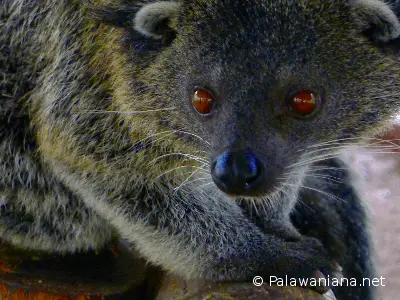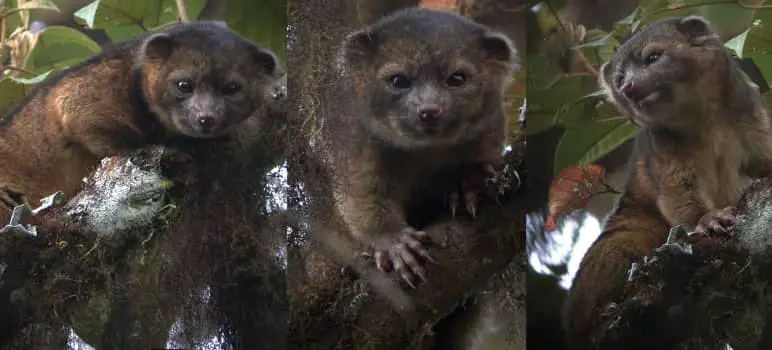Have you heard or read about a new mammal species discovered on Mount Andes in South America? It is called olinguito. The bearcat resembles it. See the difference.
As I browsed the internet for current information on science, I bumped into the Science Daily website featuring olinguito (Bassaricyon neblina), a mammal species of mistaken identity.
What first struck my attention is that olinguito resembles the mammal I took a shot two weeks ago in a wildlife conservation facility. It is called the Palawan bearcat.
I describe in the next section the difference and similarities between these two mammal species.
Olinguito vs Bearcat
Examining the picture of the newly discovered mammal species closely, I could not help but compare it with the bearcat (Arctictis binturong whitei) which is found in Palawan Island, in the western part of the Philippines. According to the report, the olinguito looks like a cross between a house cat and a teddy bear.
The researchers similarly described the Palawan bearcat. They also described it as a cross between a bear and a cat, but it neither belongs to the bear nor the cat family. The mammal belongs to the family Viverridae [1].
For copyright reasons, I could not post a picture of the olinguito for comparison here at the time of the first report about this animal. But 10 years later when I came back to this article to update it, I found a creative commons picture of olinguito. Hence, I also display the picture of olinguito to show a visual representation of the two and compare them.
Indeed, the olinguito looks very much similar to the mammal found in the western part of the Philippines, on the island of Palawan.
You may also click the link to the ABC News website to see a picture of olinguito that bears close resemblance to the bearcat I show below.

Feeding Habit of the Bearcat vs the Olinguito
The Palawan bearcat is sometimes treated as a distinct species although it looks very much like the ones found in Borneo. It has a prehensile tail, meaning, its tail can grasp an object. This is because the bearcat lives in tree canopies to feed on both plant material and other smaller animals like insects, rodents, birds and even fish[2]. Thus, it is omnivorous (animal and plant eater) as opposed to olinguito which is a carnivore. It only eats flesh.

The information on olingo’s feeding habit, however, is confusing because the headline in Science Daily says it is a carnivore. But scrolling down further on the website, it reports that during the three-week expedition of Helgen and Kays; they noted it is a nocturnal animal and feeds mainly on fruits [3].
This requires further study as the discovery of this new species spurred interest in finding out more about its characteristics, habitat, distribution and conservation. More expeditions are being planned at the moment.
Behavior
I find the bearcat much cuter than the olinguito. In fact, tourists love to have the tamed bearcat on their shoulders for a quick shot every time they visit the Palawan Wildlife Rescue and Conservation Center (PWRCC) where several of them are kept in captivity. Placing the bearcat on one’s shoulders, however, is a dangerous practice because the bearcat can rip flesh easily, just like a bear.
More than a decade ago, I saw someone made the mistake of handling it when it was already big and got slashed by its razor-sharp claws. It is docile when tamed, but accidents happen.
Size Comparison
The bearcat grows up to 1.4 meters and weighs more than 20 kilograms as opposed to olinguito’s two pounds. This probably is the reason olinguito was named so. It is a small olingo.
A Demonstration of Keenness
New findings like this arise from a keen sense of observation, which good researchers must possess. For many years, the olinguito was regarded as a species of kinkajou, another mammal living within the same geographic range. But it took a team of scientists headed by Helgen, who noticed olinguito’s smaller teeth and skull in the museum collections, to uncover a feature that everyone overlooked.
Keenness is the key.
References
1. Wilson, D. E.; Reeder, D. M. Mammal Species of the World (3rd ed.). Johns Hopkins University Press. pp. 548–559. Retrieved August 16, 2013, from http://www.departments.bucknell.edu/biology/resources/msw3/browse.asp?id=14000270
2. Widmann, P., De Leon, J. & Duckworth, J.W. 2008. Arctictis binturong. In: IUCN 2013. IUCN Red List of Threatened Species. Version 2013.1. . Downloaded on 16 August 2013.
3. Smithsonian Institute (2013, August 15). New species of carnivore looks like a cross between a house cat and a teddy bear. ScienceDaily. Retrieved August 16, 2013, from http://www.sciencedaily.com /releases/2013/08/130815143101.htm
© 2013 August 16 P. A. Regoniel | Updated 2023 January 22


